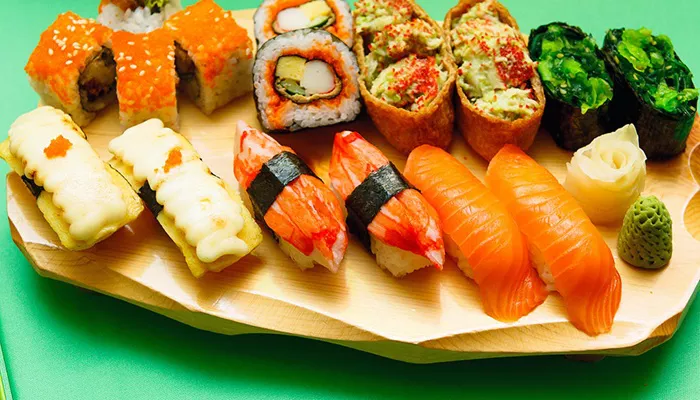Sakae Sushi is a well-known restaurant chain that specializes in Japanese cuisine. Founded in Singapore in 1997 by Douglas Foo, it has grown to become a prominent player in the sushi market, operating over 250 outlets across multiple countries.
The brand is recognized for its affordable prices and innovative dining experience, particularly through its use of a sushi conveyor belt system. This article will delve into the Sakae Sushi franchise, covering its introduction, costs, conditions, process, and potential profits.
Sakae Sushi Brand Introduction
Sakae Sushi is the flagship brand of Sakae Holdings Ltd. The name “Sakae” translates to “prosperity” in Japanese, reflecting the brand’s mission to provide high-quality Japanese food at reasonable prices. The restaurant offers a wide variety of dishes, including sushi, sashimi, teppanyaki, ramen, and donburi.
The unique selling point of Sakae Sushi is its kaiten (conveyor belt) dining experience, where customers can select dishes as they pass by on a moving belt. This concept not only enhances the dining experience but also allows for quick service and a casual atmosphere. Over the years, Sakae Sushi has adapted to market trends by introducing healthier options and innovative menu items, such as rice enriched with Vitamin E.
see also: Boon Tong Kee Franchise
Sakae Sushi Franchise Cost
Starting a franchise with Sakae Sushi requires significant investment. The cost structure includes various components:
Initial Investment: The total investment required to open a Sakae Sushi franchise ranges from USD 500,000 to USD 700,000. This amount varies based on location and market conditions.
Franchise Fee: A one-time franchise fee of approximately USD 100,000 is required when entering into an agreement with Sakae Sushi.
Royalties: Franchisees are required to pay ongoing royalties that range from 5% to 8% of gross sales. These fees contribute to brand marketing and support services provided by Sakae Holdings.
Breakdown of Costs
Initial Setup Costs: This includes expenses for leasing or purchasing property, renovations, equipment purchase (like sushi conveyors), and initial inventory.
Operational Costs: Franchisees should also budget for ongoing operational costs such as staff salaries, utilities, supplies, and maintenance.
Marketing Expenses: While some marketing support is provided by Sakae Holdings, franchisees are encouraged to invest in local marketing efforts to attract customers.
Sakae Sushi Franchise Conditions
To become a franchisee of Sakae Sushi, applicants must meet certain criteria:
Business Experience: While prior experience in the food and beverage industry is beneficial, it is not mandatory. However, having strong management skills and business acumen is essential.
Financial Capability: Prospective franchisees must demonstrate sufficient financial resources to cover initial investment costs and sustain operations during the early stages of business.
Commitment to Quality: Franchisees must adhere to Sakae Sushi’s standards for food quality and customer service. This includes following specific recipes and operational procedures established by the brand.
Location Approval: The chosen location for the franchise must be approved by Sakae Holdings to ensure it aligns with the brand’s target market and demographic profile.
Sakae Sushi Franchise Process
The process of becoming a Sakae Sushi franchise owner involves several steps:
Initial Inquiry: Interested individuals can start by contacting Sakae Holdings through their official website or franchise inquiry forms.
Application Submission: After expressing interest, potential franchisees must submit an application detailing their background and financial capability.
Franchise Disclosure Document (FDD): Upon approval of the application, candidates will receive an FDD that outlines all terms and conditions associated with the franchise agreement.
Interview Process: Candidates may be required to attend an interview where they discuss their business plans and vision for operating a Sakae Sushi outlet.
Site Selection: Once approved as a franchisee, candidates will work with Sakae Holdings to select an appropriate site for their restaurant.
Training Program: Franchisees must complete a comprehensive training program that covers all aspects of restaurant operations including food preparation, customer service standards, and management practices.
Grand Opening: After completing training and setting up the restaurant according to brand specifications, franchisees can plan their grand opening with support from Sakae Holdings.
Sakae Sushi Franchise Profit Potential
The profitability of a Sakae Sushi franchise can vary based on several factors including location, management efficiency, and market demand for sushi restaurants. Here are some insights into potential earnings:
Revenue Generation: A well-managed Sakae Sushi outlet can generate substantial revenue due to its popular menu items and unique dining experience. Locations in high foot traffic areas tend to perform better financially.
Average Sales Figures: While specific sales figures can vary widely between locations, successful franchises often report monthly sales ranging from USD 50,000 to USD 100,000 or more depending on factors like location size and customer volume.
Return on Investment (ROI): Franchise owners can expect an ROI within three to five years if they effectively manage costs and maintain high customer satisfaction levels.
Factors Influencing Profitability
Location: High visibility locations in urban centers or shopping malls typically attract more customers.
Marketing Strategies: Effective local marketing campaigns can significantly boost sales.
Operational Efficiency: Streamlined operations reduce costs and improve service speed which enhances customer satisfaction.
Menu Innovation: Regularly updating the menu with new items can attract repeat customers while appealing to new ones.
Customer Experience: Providing excellent service enhances repeat business which is crucial for long-term profitability.
Conclusion
The Sakae Sushi franchise presents an exciting opportunity for entrepreneurs interested in entering the food and beverage industry with a reputable brand known for its quality Japanese cuisine. With its unique dining concept centered around affordability and innovation, Sakae Sushi continues to thrive in various markets worldwide.
Investing in this franchise requires careful consideration of costs and conditions but offers significant profit potential for those willing to commit to maintaining high standards of service and quality. As Japanese cuisine continues to gain popularity globally, becoming part of the Sakae Sushi family could be a lucrative venture for aspiring restaurant owners.
Related topics:
- Cold Stone Creamery Franchise Costs, Profit & Requirements For 2024
- Hokkein Mee Franchise Costs, Profit & Requirements For 2024
- Roti Prata House Franchise Costs, Profit & Requirements For 2024

